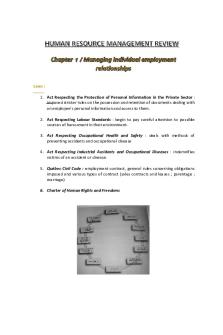Resource based PDF

| Title | Resource based |
|---|---|
| Author | Pizza regina |
| Course | International Business |
| Institution | University of Regina |
| Pages | 2 |
| File Size | 99.6 KB |
| File Type | |
| Total Downloads | 103 |
| Total Views | 154 |
Summary
Resource based...
Description
RESOURCE-BASED CONSIDERATIONS ❖ VALUE Firm resources must create value when engaging rivals. One way to add value is patenting. Also, the ability to attack in multiple markets adds value. Likewise, the ability to rapidly respond to challenges also adds value. A dominant position in key markets and a strong sphere of influence poses credible threats to rivals. ❖ RARITY
Either by nature of nurture (or both), certain assets are very rare, the generating significant advantages. ❖ IMITABILITY
Most rivals watch each other and probably have a fairly comprehensive picture of how their rivals compete. However, the newt hurdle lies in how to imitate successful rivals. → Slow-moving firms often find it difficult to do so. ❖ ORGANIZATION
Some firms are better organized for competitive actions, such as stealth attacks and answering challenges “tit-for-tat”. On the other hand, more centrally coordinated firms may be better mutual forbearers than firms whose units are loosely controlled. → For an MNE competing with rivals across many countries, a mutual forbearance strategy requires some units, out of respect for rivals’ sphere of influence, to sacrifice their maximum market gains by withholding some efforts. If a firm has competitive reward systems, unit managers may be unwilling to give up market gains for the greater benefit of the whole firm, thus undermining mutual forbearance. ❖ RESOURCE SIMILARITY
Resource similarity = the extent to which a given competitor possesses strategic endowments comparable to those of the focal firm. Firms with a high degree of resource similarity are likely to have similar competitive actions. If we put together resource similarity and market commonality, we can yield a framework of competitor analysis for any pair of rivals (figure 8.4).
C(4): little mutual forbearance, the intensity of rivalry is likely to be the highest. C(1): The intensity of rivalry might be the lowest. C(2) and C(3) represent an intermediate level of competition. Starbucks and Mc Donald’s started at cell 1 but their resource similarity has increase to C(2). ➪ Overall, conscientious mapping along the dimensions outlined in figure 8.4 can help managers sharpen their analytical focus, allocate resources in proportion to the degree of threat each rival presents, and avoid nasty surprises....
Similar Free PDFs

Resource based
- 2 Pages

Rule based vs Principle based
- 2 Pages

L3-Chemistry-resource
- 4 Pages

3 C++ Resource Management
- 4 Pages

Human resource statergy
- 10 Pages

Resource Allocation Methods
- 1 Pages

HUMAN RESOURCE MANAGEMENT.pdf
- 286 Pages

Multicore programming resource guide
- 53 Pages

PREA Resource Center questions
- 1 Pages

NATURAL RESOURCE MANAGEMENT
- 49 Pages

Human Resource Managemet
- 3 Pages

Human Resource Management Review
- 40 Pages
Popular Institutions
- Tinajero National High School - Annex
- Politeknik Caltex Riau
- Yokohama City University
- SGT University
- University of Al-Qadisiyah
- Divine Word College of Vigan
- Techniek College Rotterdam
- Universidade de Santiago
- Universiti Teknologi MARA Cawangan Johor Kampus Pasir Gudang
- Poltekkes Kemenkes Yogyakarta
- Baguio City National High School
- Colegio san marcos
- preparatoria uno
- Centro de Bachillerato Tecnológico Industrial y de Servicios No. 107
- Dalian Maritime University
- Quang Trung Secondary School
- Colegio Tecnológico en Informática
- Corporación Regional de Educación Superior
- Grupo CEDVA
- Dar Al Uloom University
- Centro de Estudios Preuniversitarios de la Universidad Nacional de Ingeniería
- 上智大学
- Aakash International School, Nuna Majara
- San Felipe Neri Catholic School
- Kang Chiao International School - New Taipei City
- Misamis Occidental National High School
- Institución Educativa Escuela Normal Juan Ladrilleros
- Kolehiyo ng Pantukan
- Batanes State College
- Instituto Continental
- Sekolah Menengah Kejuruan Kesehatan Kaltara (Tarakan)
- Colegio de La Inmaculada Concepcion - Cebu



